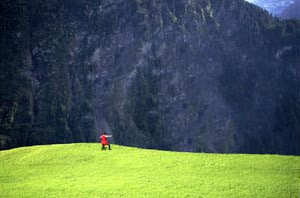
Su-Mei Tse, Ekot, 2003 © Su-Mei Tse
The 1st at Moderna: Su-Mei Tse
1.6 2004 – 12.9 2004
Stockholm
When Su-Mei Tse was awarded the Golden Lion at the 2003 Venice Biennal for her works in the Luxembourg pavilion, she was relatively unknown on the international art scene. The pavilion comprised a suite of rooms in succession, each of which contained a single or a number of works in various techniques. The rooms were arranged with musical sensibility. The first room was soundproof, which for the viewer – or for the listener, rather – created a kind of zero-point at which one could forget about the sounds from the street outside. In the soundproof room, the attention of the viewer was sharpened, the pace slowed down and after a moment one heard only the sound of one’s own breathing.
The two video pieces, “The Desert Sweepers” and “Echo”, were presented in adjacent rooms connected by an open passage. The two works do not form a diptych, but Su-Mei Tse prefers them to be shown next to each other so that the sound of the pieces can be heard between them.
In the catalogue – from which the Cage quotation above is taken – critic and freelance curator Deepak Ananth compares Tse’s work to haiku poetry. It is an appropriate comparison. The restricted format of haikus and the slightly – from our Western perspective – absurd images are features which are also found in Su-Mei Tse’s work. Haiku poetry has an openness in relation to its interpretation that takes different routes than that of rational thinking.
We encounter such an image in the piece “The Desert Sweepers”. In a desert landscape a number of road sweepers have been placed in a diminishing scale towards the horizon, in a way that clearly reveals that the image is computer generated. They wear the same kind of uniforms and use the same kind of plastic brooms as the street cleaners of Paris. Not much happens in the film. The road sweepers stay in place and sweep. Sometimes they take a break and look out over the desert. The piles of sand they sweep together never seem to grow. But the workers show no signs of frustration and they carry on working methodically. The rhythmic sound created by the brooms as they sweep across the sand is in fact the sound of road sweepers’ brooms sweeping over asphalt, recorded in Paris. The sound is one of Su-Mei Tse’s memories from her time as a student in Paris. Tse has compared the sound to that of breathing and of the regular tick-tacking of a metronome.
How to interpret the strange image (and the sound) of the desert sweepers? Perhaps one has to accept, as with haiku poems, that the images are not carrying meaning in the sense that they are translatable. Similarly, it might be meaningless to sweep the desert, unless, of course, one appreciates the sound. A quietly humorous image to meditate upon? Or is the transportation of the Parisian road sweepers to the desert to be seen as a metaphor for the situation of immigrants? An experience that Su-Mei Tse, with her multicultural background (born in Luxembourg of British and Chinese parents and with German as her first language) probably shares with many of Paris’ road sweepers.
The musical theme is perhaps more accentuated in the other video piece, “Echo”. A young woman, the artist herself, sits in front of a sublime Alpine landscape playing the cello. In the pauses, the echo answers.
Curator: Magnus af Petersens
The 1st at Moderna is an exhibition programme for contemporary art. The opening is always on the first day of the month, and the exhibitions are in different venues in or outside the museum.
